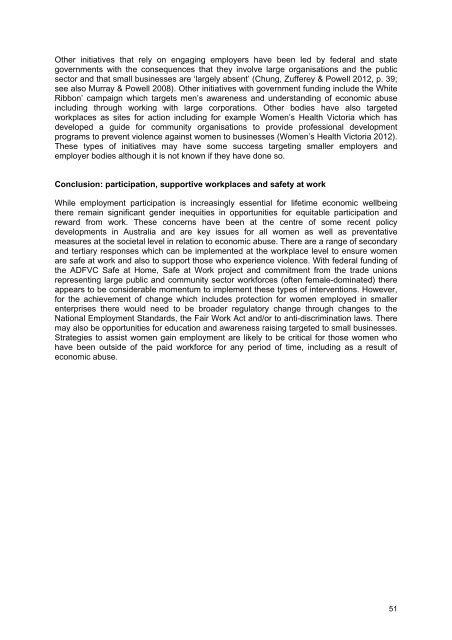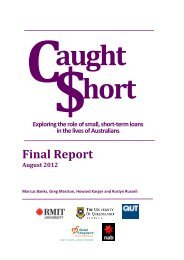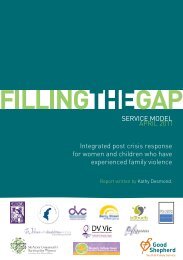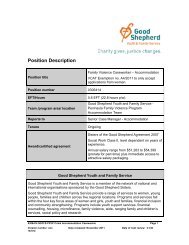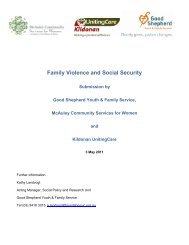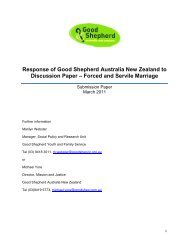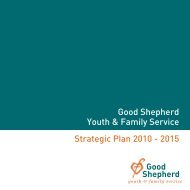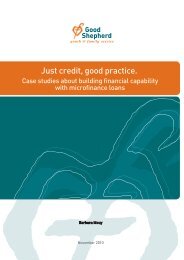Spotlight on Economic Abuse: a Literature and Policy Review
Spotlight on Economic Abuse: a Literature and Policy Review
Spotlight on Economic Abuse: a Literature and Policy Review
You also want an ePaper? Increase the reach of your titles
YUMPU automatically turns print PDFs into web optimized ePapers that Google loves.
Other initiatives that rely <strong>on</strong> engaging employers have been led by federal <strong>and</strong> state<br />
governments with the c<strong>on</strong>sequences that they involve large organisati<strong>on</strong>s <strong>and</strong> the public<br />
sector <strong>and</strong> that small businesses are ‘largely absent’ (Chung, Zufferey & Powell 2012, p. 39;<br />
see also Murray & Powell 2008). Other initiatives with government funding include the White<br />
Ribb<strong>on</strong>’ campaign which targets men’s awareness <strong>and</strong> underst<strong>and</strong>ing of ec<strong>on</strong>omic abuse<br />
including through working with large corporati<strong>on</strong>s. Other bodies have also targeted<br />
workplaces as sites for acti<strong>on</strong> including for example Women’s Health Victoria which has<br />
developed a guide for community organisati<strong>on</strong>s to provide professi<strong>on</strong>al development<br />
programs to prevent violence against women to businesses (Women’s Health Victoria 2012).<br />
These types of initiatives may have some success targeting smaller employers <strong>and</strong><br />
employer bodies although it is not known if they have d<strong>on</strong>e so.<br />
C<strong>on</strong>clusi<strong>on</strong>: participati<strong>on</strong>, supportive workplaces <strong>and</strong> safety at work<br />
While employment participati<strong>on</strong> is increasingly essential for lifetime ec<strong>on</strong>omic wellbeing<br />
there remain significant gender inequities in opportunities for equitable participati<strong>on</strong> <strong>and</strong><br />
reward from work. These c<strong>on</strong>cerns have been at the centre of some recent policy<br />
developments in Australia <strong>and</strong> are key issues for all women as well as preventative<br />
measures at the societal level in relati<strong>on</strong> to ec<strong>on</strong>omic abuse. There are a range of sec<strong>on</strong>dary<br />
<strong>and</strong> tertiary resp<strong>on</strong>ses which can be implemented at the workplace level to ensure women<br />
are safe at work <strong>and</strong> also to support those who experience violence. With federal funding of<br />
the ADFVC Safe at Home, Safe at Work project <strong>and</strong> commitment from the trade uni<strong>on</strong>s<br />
representing large public <strong>and</strong> community sector workforces (often female-dominated) there<br />
appears to be c<strong>on</strong>siderable momentum to implement these types of interventi<strong>on</strong>s. However,<br />
for the achievement of change which includes protecti<strong>on</strong> for women employed in smaller<br />
enterprises there would need to be broader regulatory change through changes to the<br />
Nati<strong>on</strong>al Employment St<strong>and</strong>ards, the Fair Work Act <strong>and</strong>/or to anti-discriminati<strong>on</strong> laws. There<br />
may also be opportunities for educati<strong>on</strong> <strong>and</strong> awareness raising targeted to small businesses.<br />
Strategies to assist women gain employment are likely to be critical for those women who<br />
have been outside of the paid workforce for any period of time, including as a result of<br />
ec<strong>on</strong>omic abuse.<br />
51


